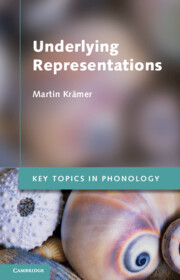Book contents
- Frontmatter
- Contents
- Acknowledgements
- Abbreviations
- 1 Getting started
- 2 Arbitrariness and opposition
- 3 Derivation and abstractness
- 4 Underspecification returns
- 5 The devil is in the detail
- 6 Psycho- and neurolinguistic evidence
- 7 On the form and contents of contrastive features
- 8 Underlying representations in Optimality Theory
- 9 Preliminary results
- Glossary
- Notes
- References
- Name index
- Language index
- Subject index
- References
2 - Arbitrariness and opposition
Published online by Cambridge University Press: 05 November 2012
- Frontmatter
- Contents
- Acknowledgements
- Abbreviations
- 1 Getting started
- 2 Arbitrariness and opposition
- 3 Derivation and abstractness
- 4 Underspecification returns
- 5 The devil is in the detail
- 6 Psycho- and neurolinguistic evidence
- 7 On the form and contents of contrastive features
- 8 Underlying representations in Optimality Theory
- 9 Preliminary results
- Glossary
- Notes
- References
- Name index
- Language index
- Subject index
- References
Summary
Dans la langue il n’y a que des différences.
(Saussure 1975: 166)OVERVIEW
Contrastive features are considered the basic building blocks of phonological representations today. This was not always the case. Originally the phoneme was considered the smallest unit distinguishing the meaning of a morpheme. This shift can be considered parallel to the shift from regarding atoms as the smallest units of physics to the research on particles, such as quarks or the Higgs boson in modern physics. Also our understanding of which features there are, how they are defined and how much of this information is present in underlying representations has changed considerably over the last 100 years. In this chapter we go back to the foundations of modern phonological theorizing on underlying forms and their elemental parts, and how these ideas developed up to the introduction of generative phonology. We will look at the arguments that led to increasing abstractness in structuralist theories and also get a grasp of the methodology to detect contrastive segments and dimensions of contrast developed by Trubetzkoy, which is more or less still standard – at least in many introductory courses to phonology – today.
In the first section you will meet Ferdinand de Saussure’s ideas that language is divided into langue and parole, roughly, grammar and speech, that every morpheme has two parts – its meaning/grammatical function and its form – and that the relation between the meaning of a word and its form are arbitrary. The second section zooms in on the idea that contrast is the only thing that matters phonologically for the form part of morphemes, and on what kinds of phonological contrast we find in language. The following sections are occupied with the development of definitions of these categories of contrast and their formalization as binary features.
- Type
- Chapter
- Information
- Underlying Representations , pp. 12 - 37Publisher: Cambridge University PressPrint publication year: 2012



